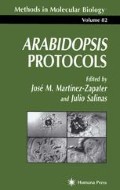Abstract
One of the many reasons for the popularity of Arabidopszs as an experimental system IS the ease with which mutant screens can be carried out on Petrt plates under sterile conditions. Petri plate screens have been successful for a number of reasons. First, large numbers of mutagenized seed can be easily scored for vartability, and secondly, plants in Petri plates can be grown constantly under completely defined condmons. These attributes open up the world of plant genetics to mutant screens similar to those described for micro-organisms For example, an Arubzdopm mutant insensitive to some particular compound such as a herbicide or growth regulator can be easily identified in a background of uniformly inhibited wild-type plants. The alternatives, spraying plants or n-rtgatmg so11 with an inhibitor, not only result m problems of uniform application, but also are complicated by evaporation and catabolism of the compound by other organisms. Aside from the ease of screening, Petri plate screens also have the advantage that retesting and genetic analysts of subsequent generations can be done under exactly the same condmons as the original screen.
Access this chapter
Tax calculation will be finalised at checkout
Purchases are for personal use only
References
Bleeker A B, Estelle M A, Somerville C.,and Kende H. (1988) Insensitivityo ethylene conferreby a dominant mutation m Arabldopsls thallana. Science 241,1086–1089.
Estell, M.A. and Somervtll, C. R. (1987) Auxm-resistant mutants of Arabzdopszs with altered morphology Mel Gen Genet 206, 200–206
Haugh, G. and Somerville C.Sulfonylurea-resistant mutants of Arabidopsis thaliana A401 Gen Genet 204, 430–434
Koornnee, M, Reulin, G, and Karsse, C M (1984) The isolation and characterization of abscisic acid-insensitive mutants of Arabldopsrs thalzana Physlol Plant 61, 377–383
Chory, J Peto, C., Fembaum, R., Pratt L., and Ausubel, F (1989) Arabzdopszs thaliana mutant that develops as a light-grown plant m the absence of light Cell 58, 991–999
Koornneef, M, Rolf, E, and Sprmt, C. J. P. (1980) Genetic control of light-inhibited hypocotyl elongation in Arabldopsu thalzana Z Pflanzenphys. 100,147–160.
Okada, K. and Shimur, Y (1990) Reversible root ttp rotation in Arabzdopsls seedlings induced by obstacle-touching stimulus. Sczence 250, 276–276.
Bsenfe, P.N., Linstea, P. J, Robert, KSchiefelbe, Jsee, M.T and Aeschbache R.A.(1993) Root development m Arabidopsis: four mutants with dramatically ltered root morphogenests.Development 119, 57–70
Author information
Authors and Affiliations
Editor information
Editors and Affiliations
Rights and permissions
Copyright information
© 1998 Human press Inc, Totowa, NJ
About this protocol
Cite this protocol
McCourt, P., Keith, K. (1998). Sterile Techniques in Arabidopsis. In: Martinez-Zapater, J.M., Salinas, J. (eds) Arabidopsis Protocols. Methods in Molecular Biology™, vol 82. Humana Press. https://doi.org/10.1385/0-89603-391-0:13
Download citation
DOI: https://doi.org/10.1385/0-89603-391-0:13
Publisher Name: Humana Press
Print ISBN: 978-0-89603-391-7
Online ISBN: 978-1-59259-268-5
eBook Packages: Springer Protocols

